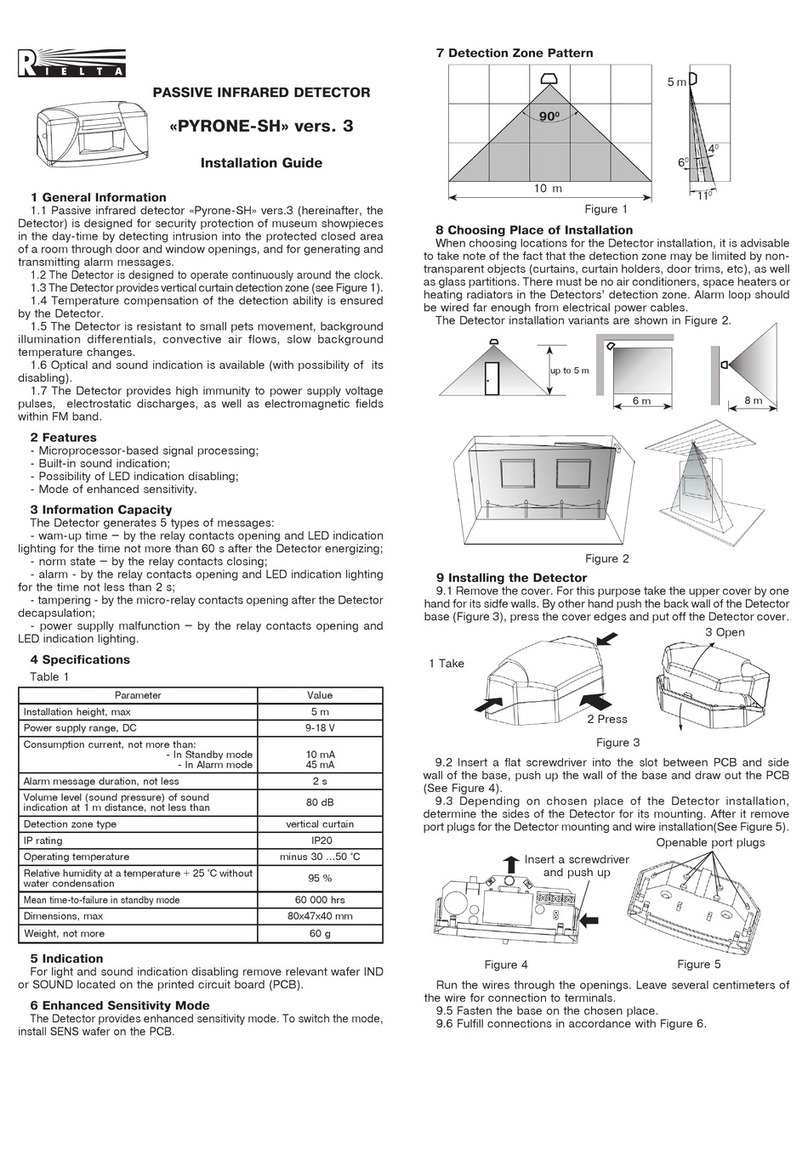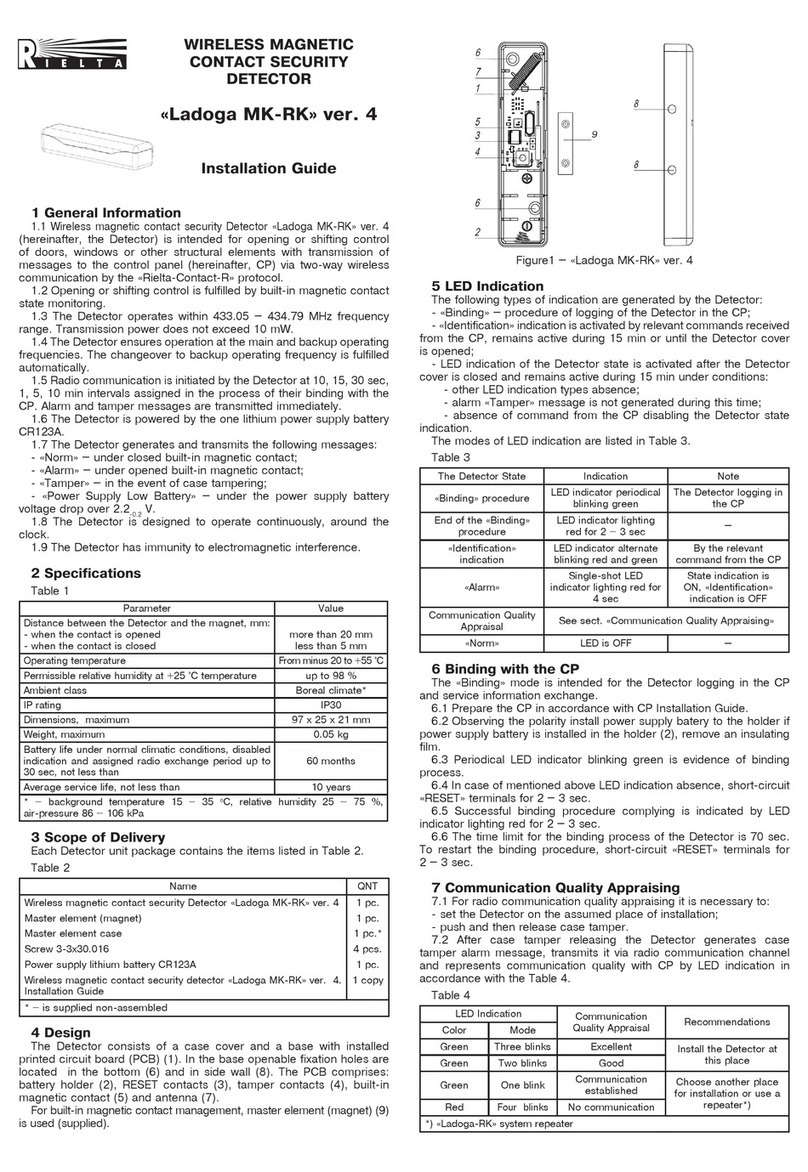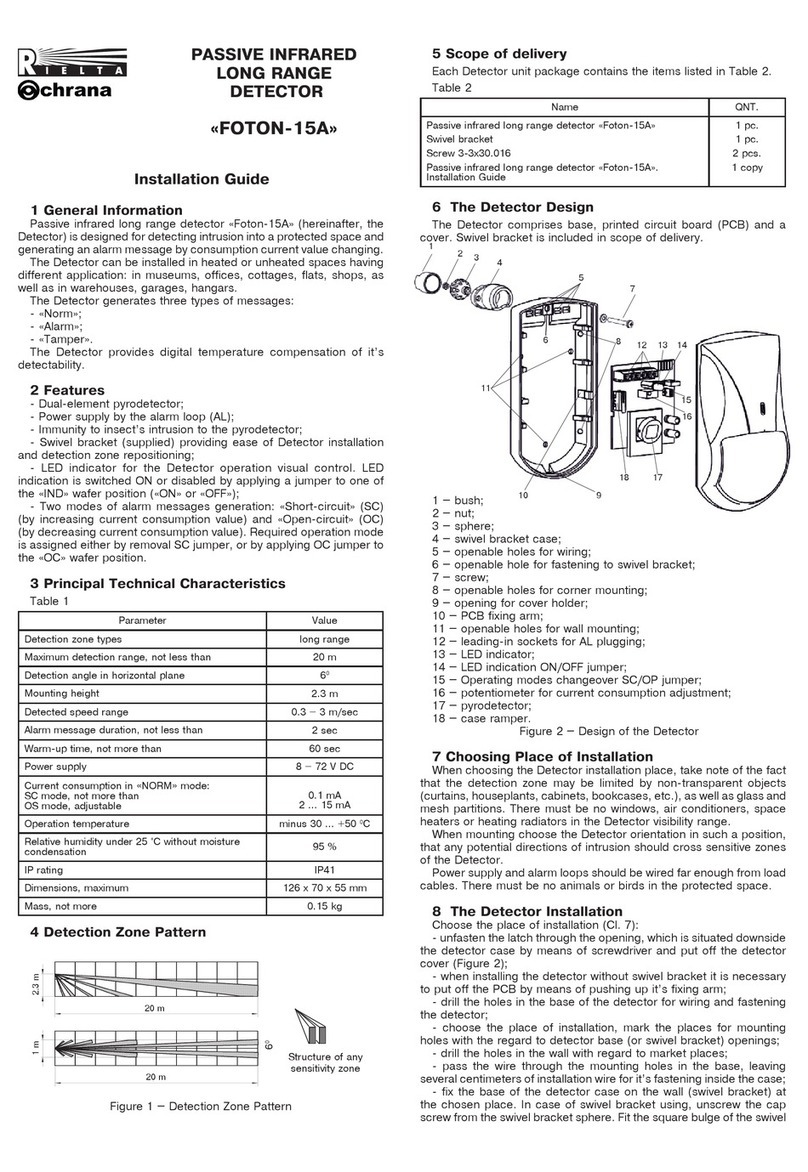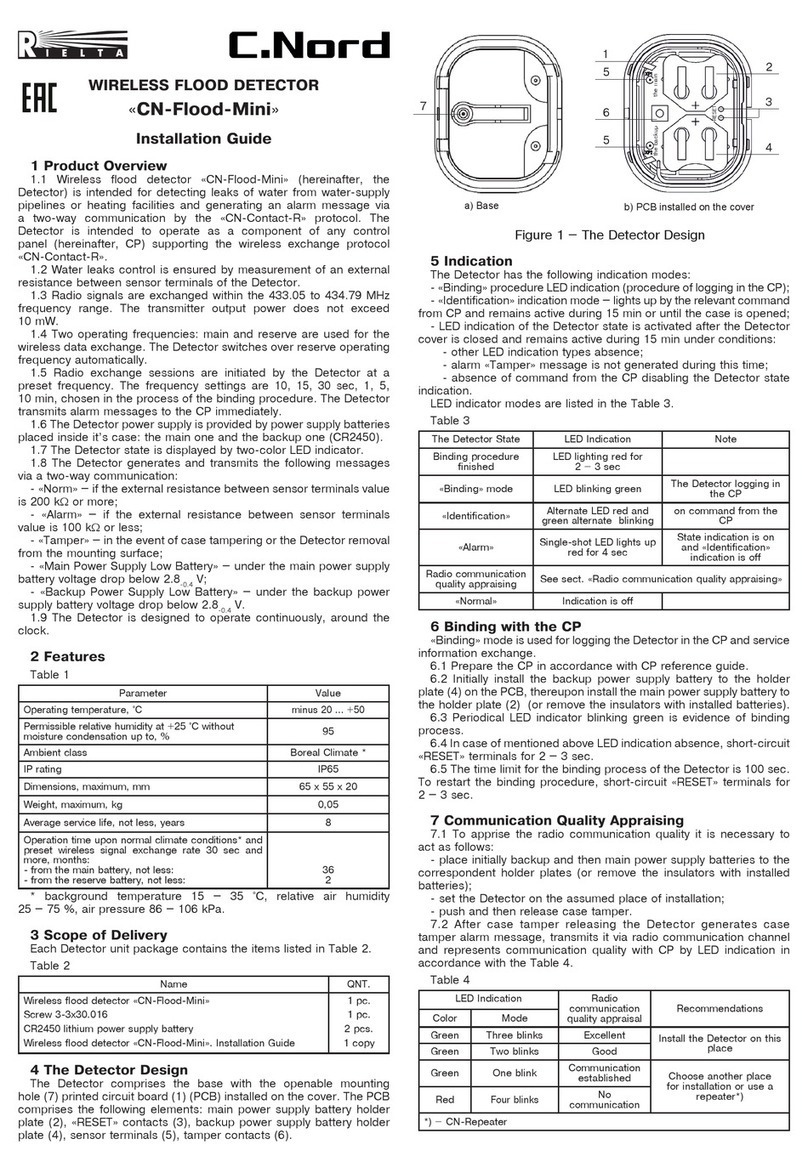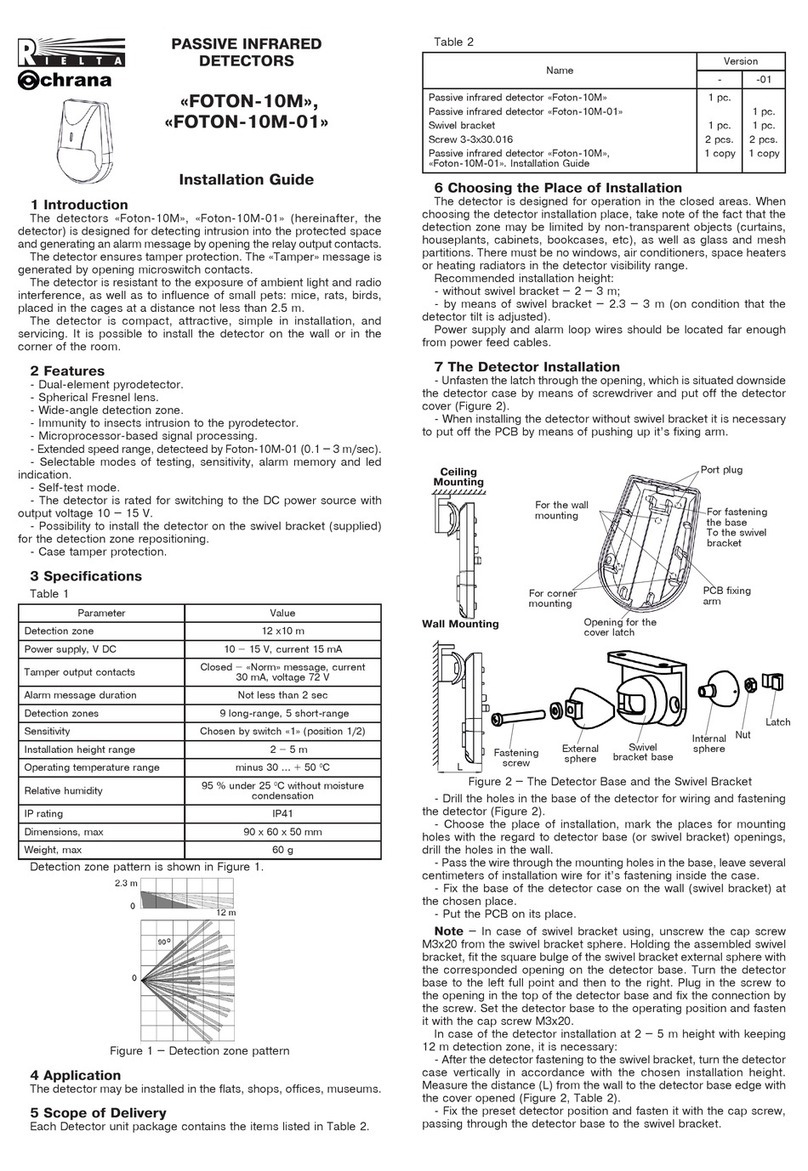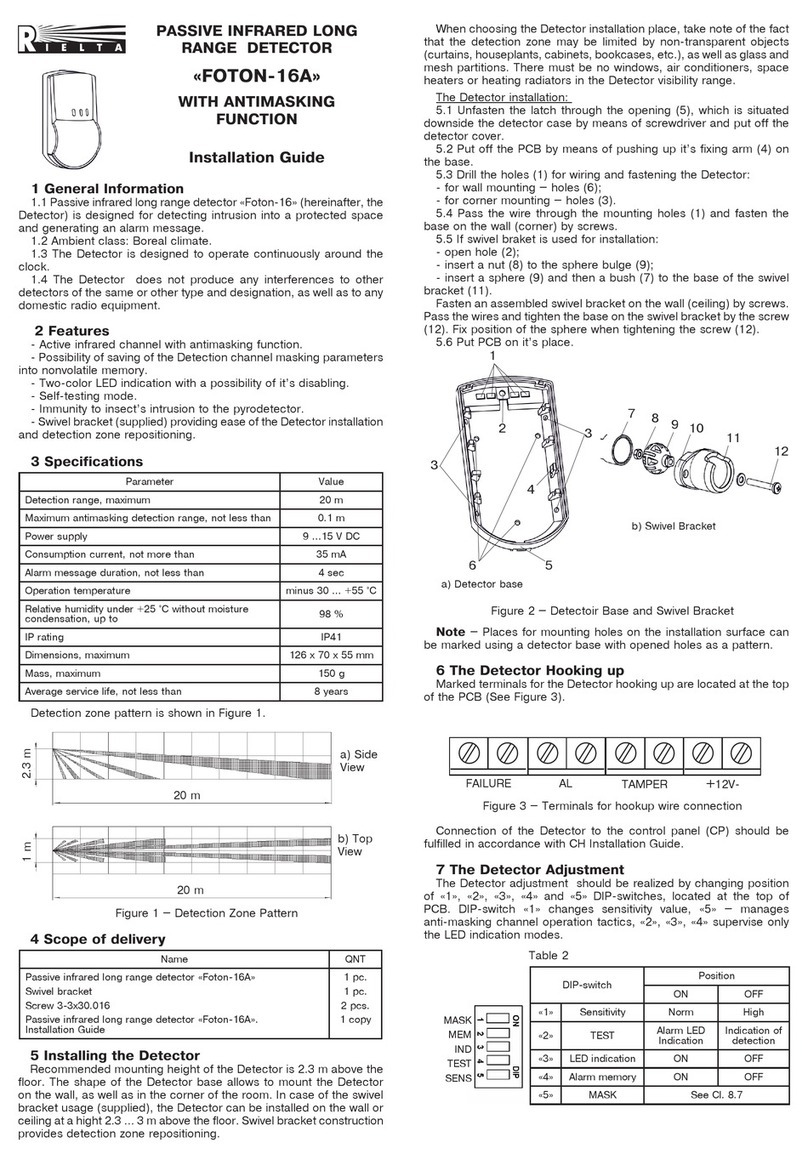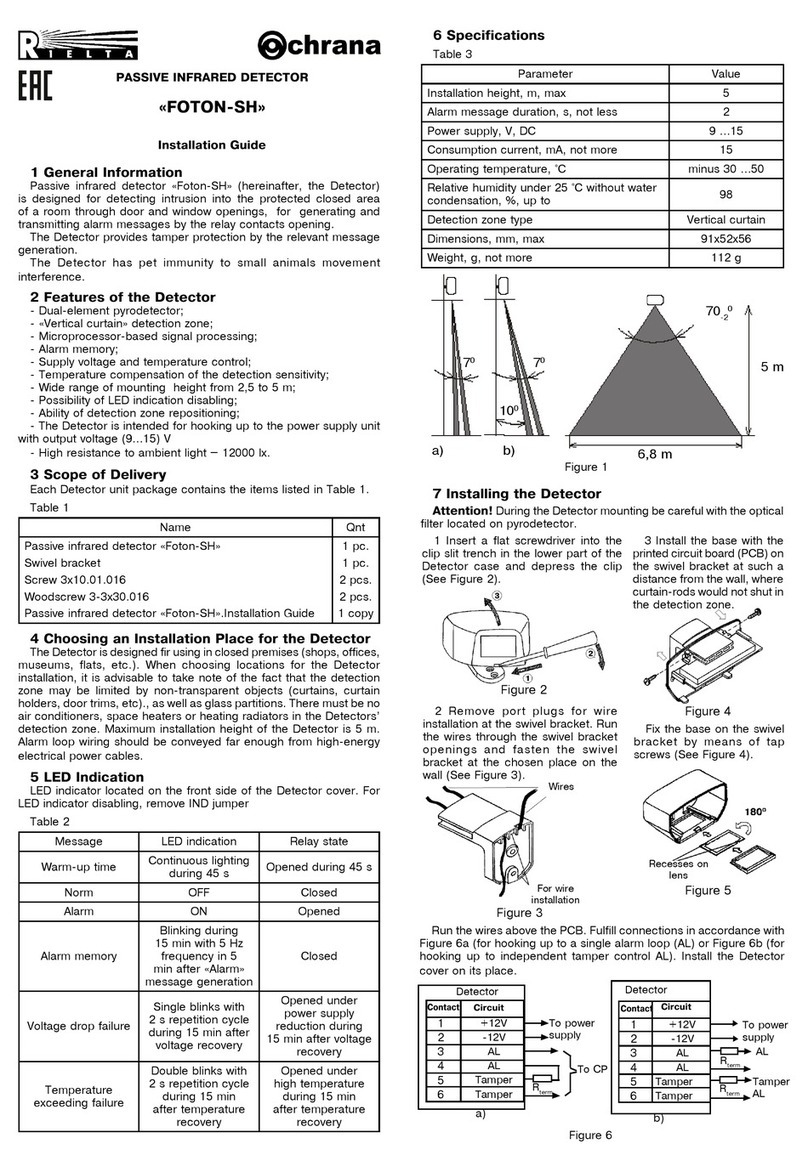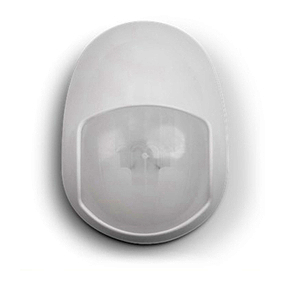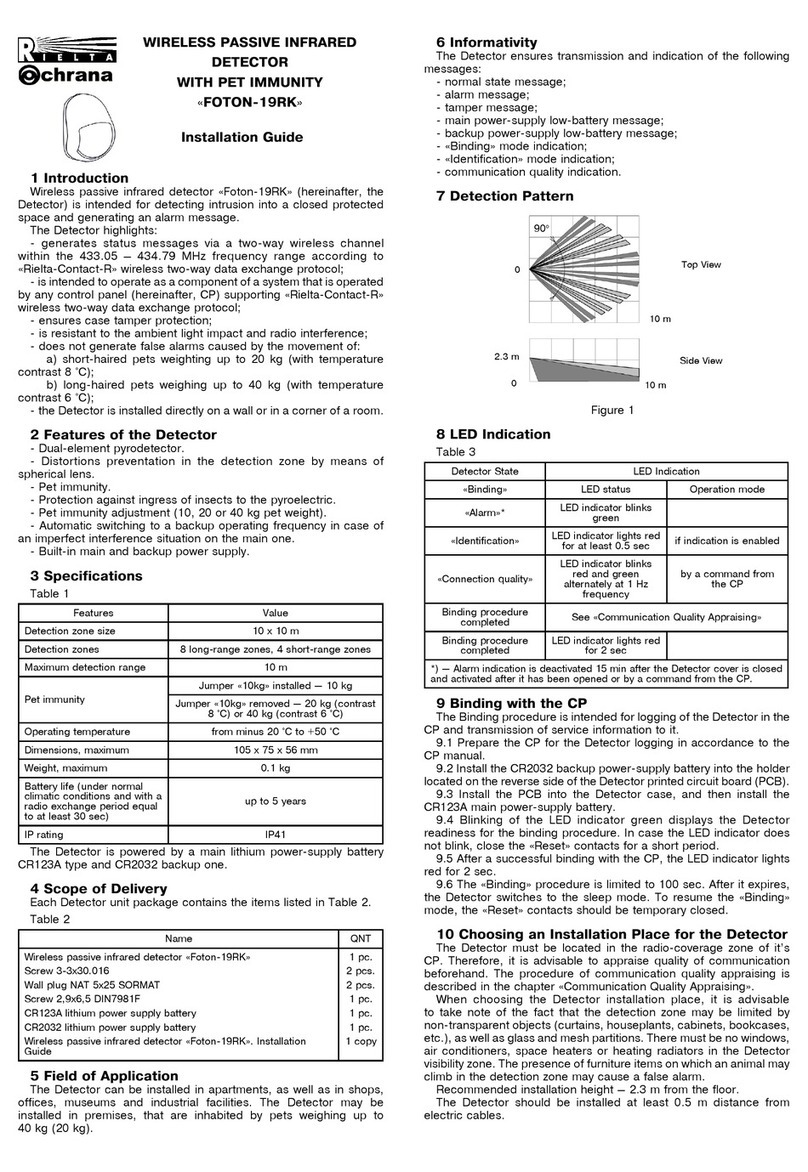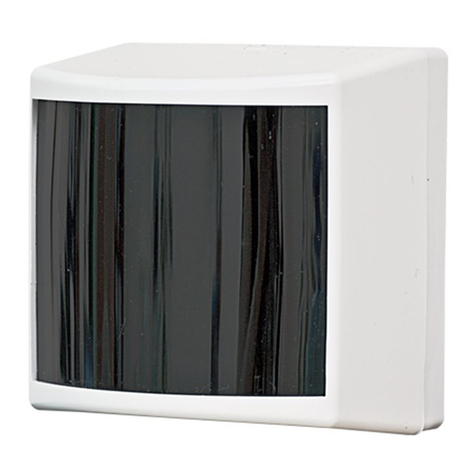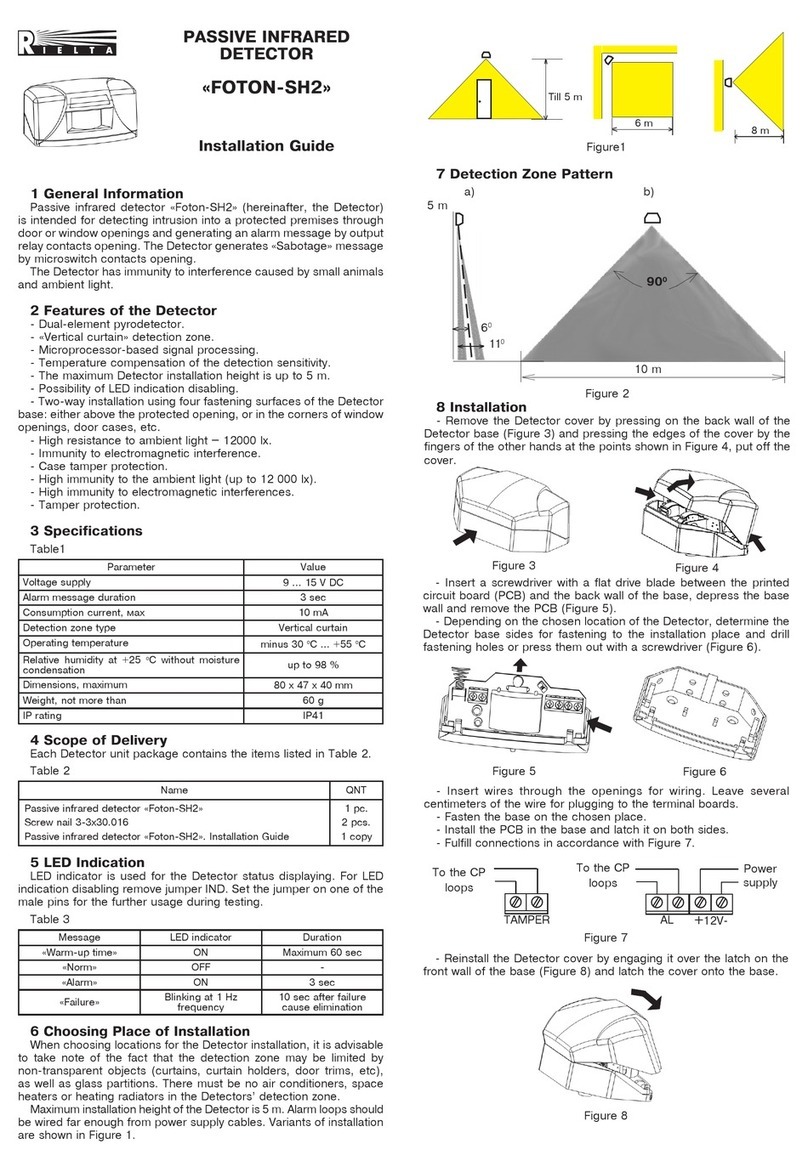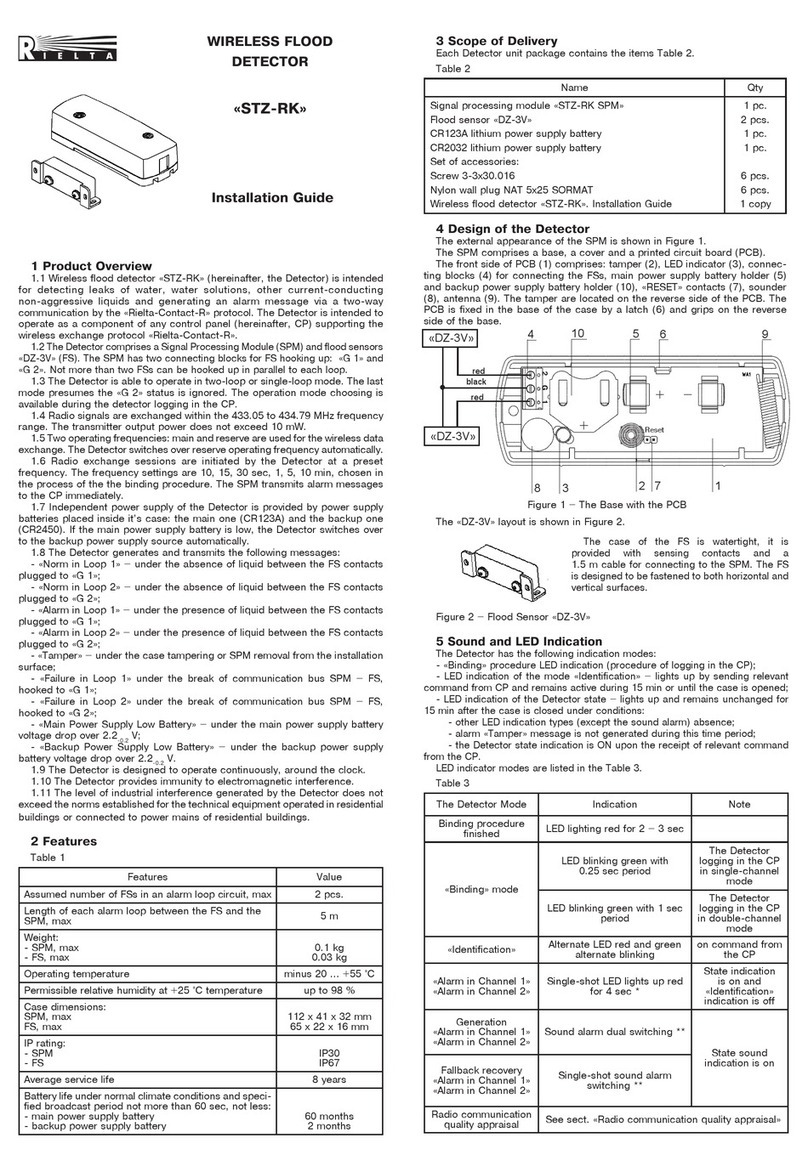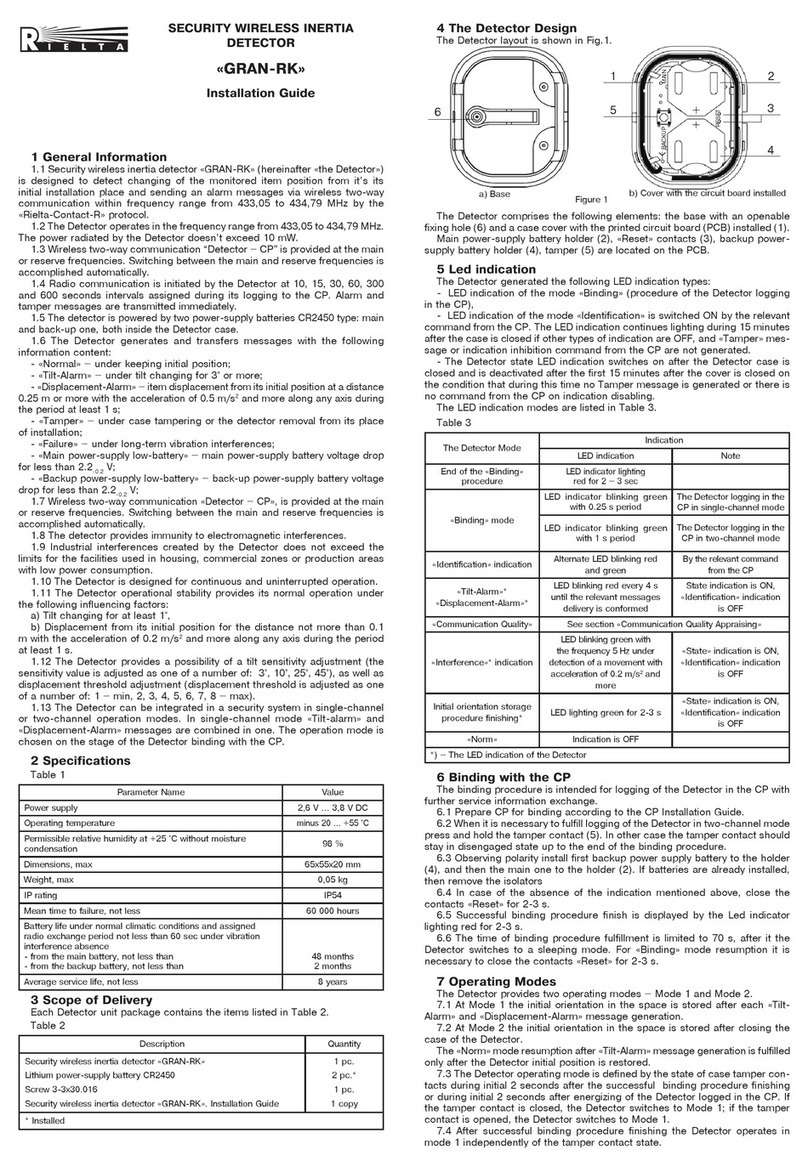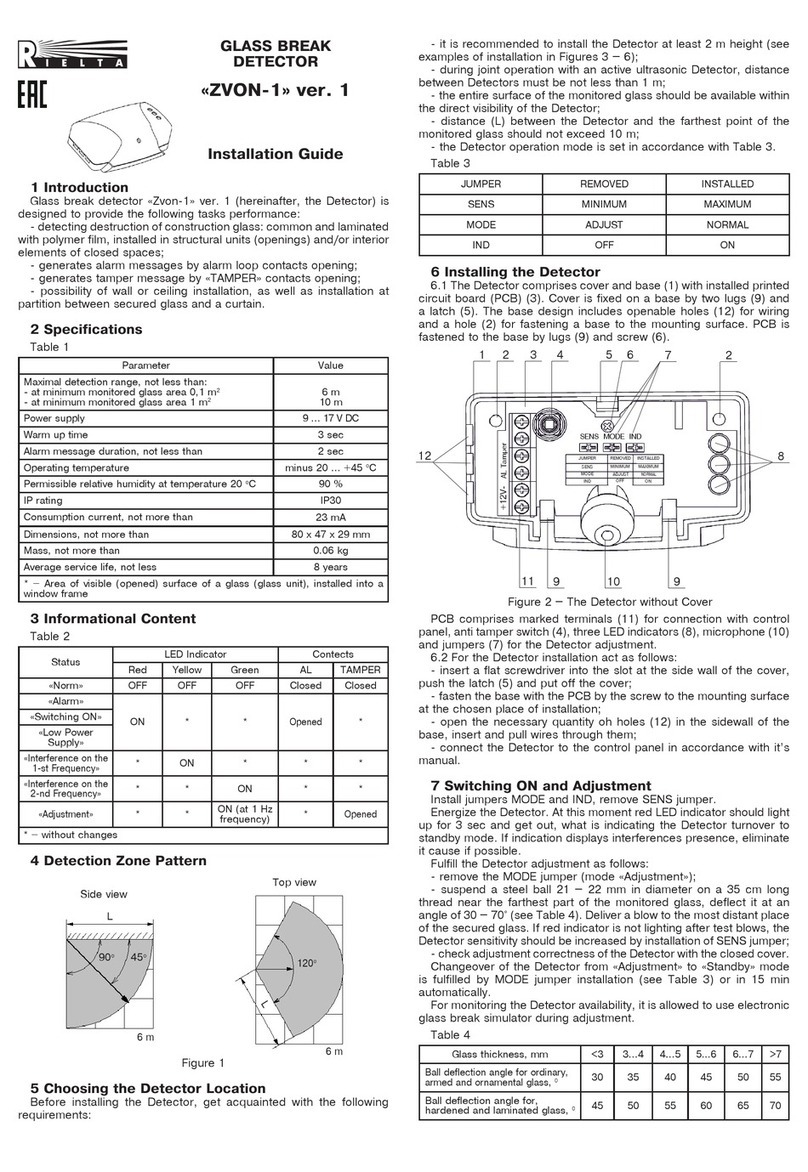
1 General Information
Seismic vibration detector “Udar” (hereinafter, the Detector) is designed to
detect attempts of premeditated destruction of the following building structures:
concrete walls and floors with the thickness not less than 0.12m, brick walls with
the thickness not less than 0.15m, wooden structure with the thickness range 20
– 40 mm, plywood with the thickness not less than 4 mm, wood chipboard with
the thickness not less than 15 mm, standard metal safes, cabinets and ATMs.
Alarm message is generated by the relay contacts opening.
The Detector provides immunity against acoustic noise, accidental impacts
on monitored structures and electromagnetic interference.
The Detector generates Alarm messages by the relay contacts opening for the
time not less than 2 s followed by the LED indication ( See Table 1).
Table 1
Mode Description
Contacts
ALARM
LED Indicators 1)
Red Green
Yellow
Messages
«Norm» Standby mode Closed O O O
«Destruction
alarm»
Destractive impact on the
secured construction Opened •Х Х
«Supply voltage
alarm»
Supply voltage lowering below
8 V Opened •• Х Х
LED Indication
«Switching ON» Self-testing after energizing Opened • • •
«Vibration»2)
Vibration of the secured
construction
Closed Х •Х
«Memory»3)
Detented LED indication of
«Destruction alarm» or «Supply
voltage alarm» messages
Closed •Х Х
«TEST 1»4) LED indication of impact tools
group I testing mode Х Х Х ••
«TEST 2»4) LED indication of impact tools
group II testing mode Х Х Х •••
«TEST 3»4) LED indication of impact tools
group III testing mode Х Х Х •
Opened – contact is opened; Closed – contact is closed; Х – do not affect;
O– LED is OFF; •– LED is ON;
•• –intermittent infrequent (two times per second) blinking;
••• – intermittent infrequent (five times per second) blinking.
1
)
–
LEDs are switched ON if DIP-switch IND is in ON position;
2) – If the Detector is operating in standby mode, LED indication “Vibration” is switched ON
in case of interference or destructive impact on the secured construction (DIP-switch TEST
in OFF position) or in case of nothing else but destructive impact of tested tools group (DIP-
switch TEST in ON position);
3
)
– LED is ON till deenergizing the Detector;
4
)
– Testing mode management is fulfilled by consequent setting DIP-switch “TEST” in ON
position and backward (Quit TEST mode).
2 Specifications
Table 2
Parameter Value
Secures area, not less:
- solid concrete, brick or wooden construction,
- metal cabinet, door, ATM upper cabinet,
- safe, ATM low cabinet
12 m2(circle with radius 2 m)
6 m2(maximum removal from the
Detector 1.4 m)
3 m2(maximum removal from the
Detector 1.4 m)
Nominal supply voltage 12 V
Supply voltage range 9-17 V
Maximum consumption current 25 mA
Detector contacts permissible current 30 mA
Detector contacts permissible voltage 72 V
Sensitivity changing 20±3 dB
Warm-up time, not more than 10 s
Ambient class Boreal climate (background
temperature 15 - 35 °С, relative
humidity 25 – 75 %, air-pressure
86-106 kPa)
Operating temperature from minus 30 to +50 °С
Relative humidity at a temperature +25 °С 90 %
IP rating IP41
Dimensions, not more 105х45х34 mm
Weight, not more 150 g
Average service life 8 years
3 Design of the Detector
Design of the Detector is shown in Figure 1
Figure 1
The base with the printed circuit board (PCB) is shown in Figure 2
4 The Detector Mounting
The Detector mounting and sensitivity adjustment is fulfilled uncovered. To
remove the cover it is necessary to loosen the latch by pushing it through the
rectangularly shaped opening (Figure 1)
Depending on the type and material of the secured surface, mounting of the
Detector is fulfilled by male screws and framing nails through the holes (See Figure
2, position 3) in the base (a distance between the holes is 35 mm) or by means
of glue. It is important that the installed Detector should have firm contact with
the surface of the secured construction.
For the Detector mounting on the brick or concrete construction metal rockbolt
(it is forbidden to mount the Detector on plastic wall plug). The depth of the
holes for the Detector mounting should be enough to provide full-length entry
of rockbolts in basic material of the secured construction without regard to the
thickness of the decorative or (and) finish coating. For mounting the Detector
on wooden constructions, it is possible to use screws (self tappers) with entry in
the basic material of the secured construction at a depth not less than 20 mm.
For mounting of the Detector on metal constructions it is recommended to
ground it. Use connection by screws with nuts M4 via openings or tap screws
M4 through openable holes. If openable holes are used, in advance tap a thread
by cutting.
The Detector mounting in a safe or ATM low cabinet is recommended to
fulfill by means of screws M4 or super glue in accordance with its manual or
recommendations on its package. Glue joint is permissible for other metal
constructions, where screw joint appliance is impossible.
5 Connection
Connection of the Detector to the control panel (hereinafter, the CP) should
be realized in accordance with connection pattern contained in CP instruction
manuals in accordance with the Detector terminal blocks designation (see Figure
2, position 5). Two openable holes in the Detector case are provided for wiring
(See Figure 2, position 7).
6 The Detector Controls
DIP-switch IND is used for LED indication switching on.
Setting DIP-switch MEM to ON position turns the Detector to alarm memory
mode.
DIP-switch TEST changes modes of a vibration sensor signal processing in
accordance with the presumed impact tools group.
TEST modes are changing cyclically after each setting DIP-switch TEST in
ON position. Chosen mode is displayed by yellow LED indicator. (See Table 1).
Sensitivity regulator component SENS (See Figure 2, position 8) provides
smooth sensitivity decrease in the range (20 ± 3) dB from it’s maximum value.
7 Adjustment
Open the Detector cover, set DIP-switch IND in ON position.
7.1 Noise level control in the place of installation
Adjust maximum sensitivity level by turning sensitivity regulator component
clockwise manner until tight
Energize the Detector, make sure in “Switching ON” indication availability with
further “NORM” message generation.
SEISMIC VIBRATION
DETECTOR
“UDAR”
Installation Guide
a)Top view without cover
1 – Hook on the cover;
2 – DIP Switch;
3 – Mounting Holes;
4 – PCB Latch;
5 – Terminal Block;
Figure 2 - Base with the PCB
6 – Cover Latch;
7 – Openable holes for wiring;
8 – Sensitivity corrector;
9 – LED indicators;
10 – Vibration sensor.
Push
b) Bottom view
10
7
3
4
3
2
5
6
8
9
1
1 2 3
TEST
MEM
IND
+12В- ALARM
ON
SENSITIVITY
Где:


